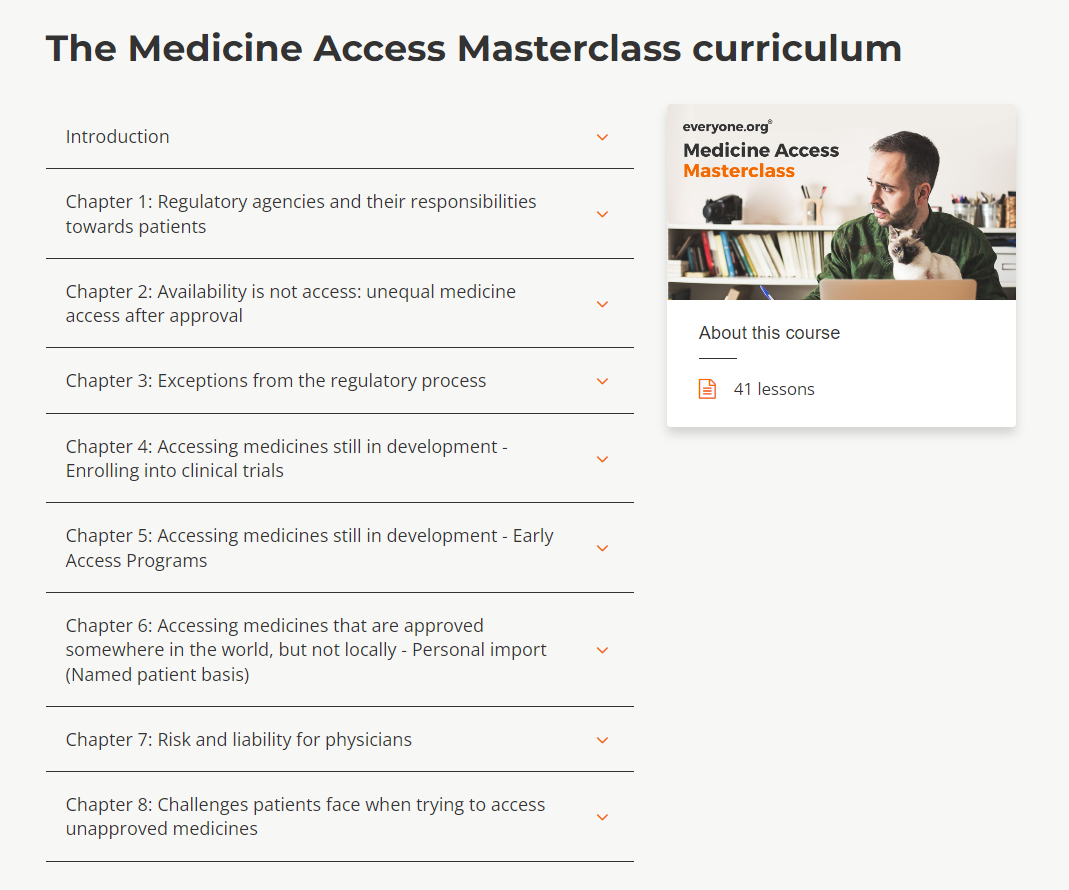Role: UX Researcher, Course Designer and Writer. Collaborated with the General Counsel, the Sourcing and Logistics Expert and the Patient Support Manager.
Main challenge: Uncovering the patients' needs, structuring and presenting medical and legal information in clear and easily understandable ways.
Wondering why a UX Designer is writing a course? Well this designer has a Bachelor's in Journalism, then took a Master's in Multimedia production and specialized in UX. While in University I wrote for a local publication, worked for a year in copywriting and dropped it the second I got a foot in the door as a UX designer. I occasionally write again when an interesting project lands in my lap and I was happy to take on this project in order to help support patients with life-threating conditions.
Everyone.org is an international pharmacy that specializes in providing medicine to patients living in countries where the medicine is not yet approved. For example, a medicine is approved in the USA, but it takes months or even years until it's approved in another country, let's take for example Japan. Everyone.org uses a little known legal pathway to provide that medicine to patients in Japan even if it's not yet approved there - but it has to be approved somewhere in the world.
Steps
1 - Gathered business requirements
I conduct user interviews regularly and we have a database of information about our various user segments, their needs, their behaviors, their wishes. We typically focus on the bottom of the funnel, the segment that reaches our website with the goal or purchasing medicine as they are the ones most likely to convert and we nurture other segments so that they will come back and convert later.
There was one untapped segment that we never could have helped because their needs delved out of our service possibilities - users who are just researching medicine and ways to access it, who are looking for medical information, a second opinion, who are searching for clinical trials. They browse our blog posts about different medicines or conditions in quite high numbers. They are nowhere near ready to buy medicine, but they are voracious gatherers of information. They are either patients who have exhausted their options or family or friends of such patients and they need different avenues than the conventional ones when it comes to treatment.
This was a user segment and an opportunity that management wanted to tap into so we could help them with valuable information that's difficult to find anywhere else and, of course, build another revenue channel. The masterclass/course idea was born.
2 - Researched users
I already had good data about user behaviors and needs from previously conducted research, I just needed to flesh this information out and make sure that a course was the type of package that our users were interested in (as opposed to podcasts, YouTube videos, series of articles etc.).
I conducted interviews with users from the segment that we wanted to target and spoke with them about their motivation for visiting the website, their wants, their needs, their past content-consuming habits and more so we could paint a good picture of their profile and whether they would be interested in a course.
We also needed to validate the course as a revenue channel to make sure that users were willing to purchase this course. For this purpose I built a landing page with Thinkific, an online course platform that we wanted to use for the course that also enabled us to launch landing pages with their own CMS. I tested multiple price points with the CTA "Buy now for EUR xxx" and monitored the conversion rate.
Once we had a good user profile, strong indications that the course is something they would want and that they would actually pay for it, the Medicine Access Masterclass was set in motion.
3 - Developed the course

I started by building the curriculum overview in accordance with our users' needs and keeping in mind the struggles that our past patients have had with understanding regulations, country-dependent restrictions, the role of the physician in accessing medicine and more.
I started writing the course making sure that the information is accessible, easy to understand without any legal or medical background, engaging and, above all else, useful. My main sources were clinical studies published on PubMed, followed by governmental websites and medicine regulator websites.
I created animations, end-of-chapter quizzes, included useful links and downloadable PDFs that I have designed.
During this entire process I consulted with a General Counsel, a Sourcing and Logistics Expert and the Patient Support Manager. The General Counsel legally checked the course after it was completed to ensure complete accuracy.
4 - Results
You can see a short walkthrough of the finalized Masterclass below:
At the time of writing this project entry, the course has just been launched and we had our first 3 sales!
Upcoming: heavy promotion of the course, giving free codes to our network of physicians and requesting feedback, as well as scheduling interviews with some of the students who finished the course.



